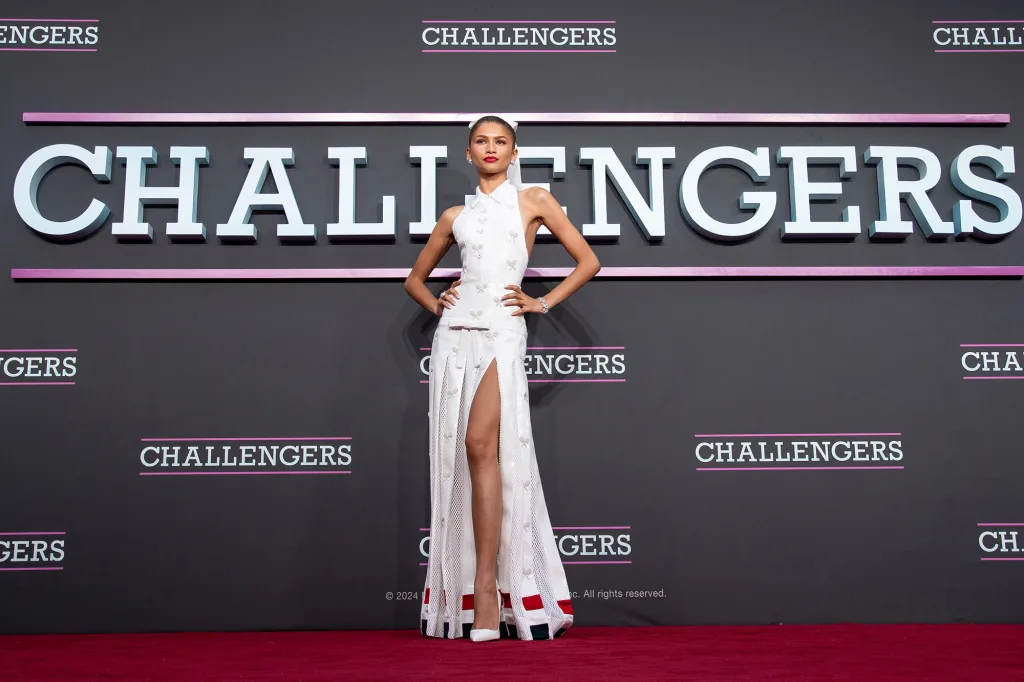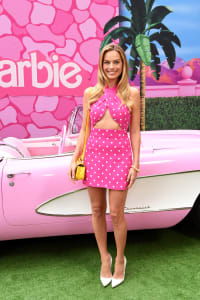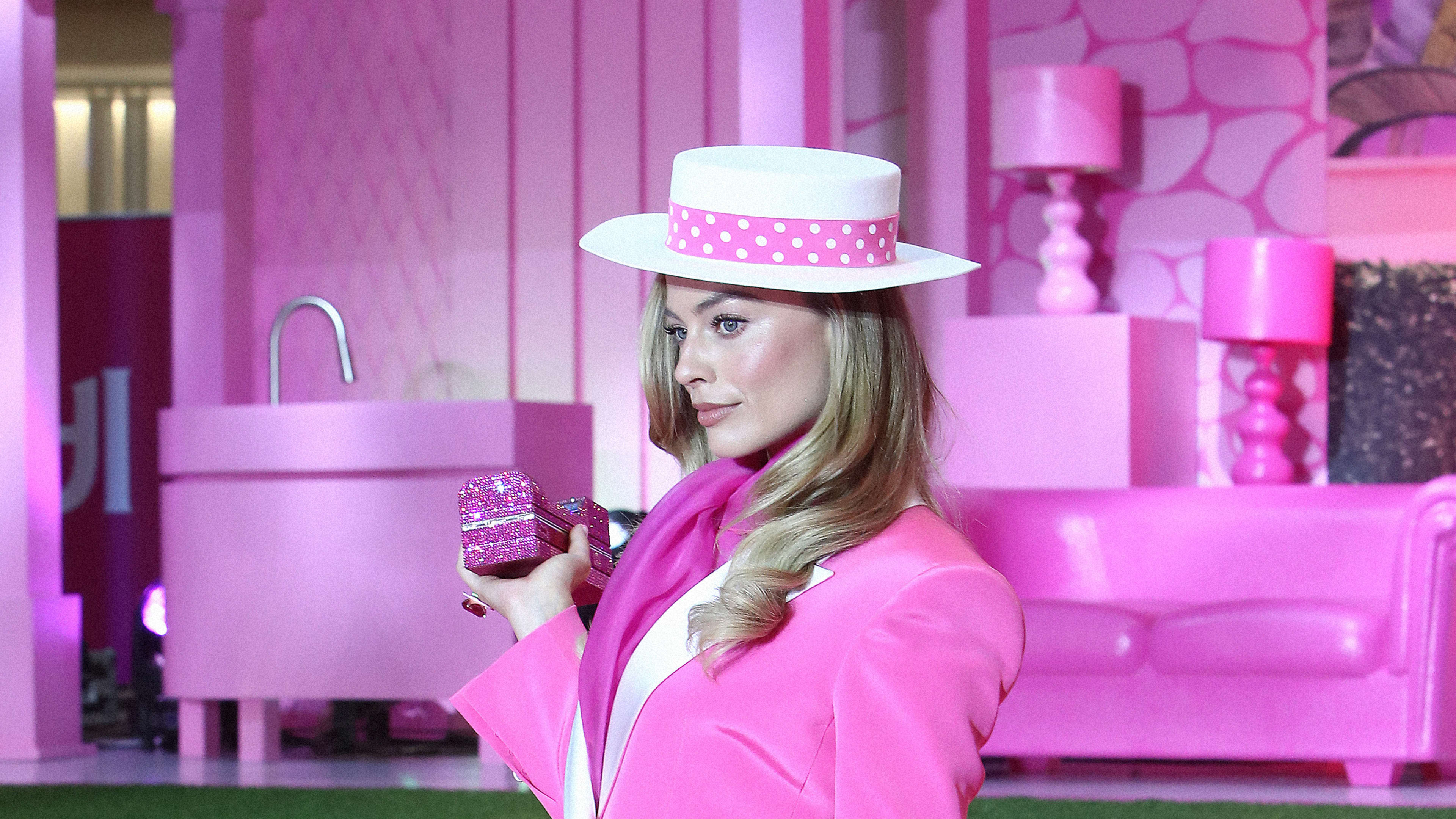From tennis ball studded stilettos to a custom Celia Kritharioti minidress emblazoned with a movie poster, Zendaya has gone all-in on the theme for her promotion of the new tennis flick Challengers.

Dressing to match a cinematic universe has become routine for Zendaya, with many others capitalizing upon the trend, as well. Most recently, Chris Pine sported jorts and a wig for the promotion of his new movie Poolman. Last year, Halle Bailey wore a mermaid-inspired dress on the red carpet as a tribute to the new live-action The Little Mermaid. This so-called “method dressing,” isn’t just for style—it also appears to be paying off at the box office.
A History of Method Dressing

Though it’s currently surging in popularity, method dressing is not new. The trend goes back to 1992 when Geena Davis wore a dress stitched like a baseball to the premiere of A League of Their Own. In 2014, Angelina Jolie selected a black leather dress and spike bracelets for the world premiere of Disney’s Maleficent. At the 2019 London premiere of The Lion King, Beyoncé arrived wearing a yellow gown, said to be representative of her character Nala.
Then method dressing exploded last summer when Margot Robbie sported several authentic Barbie outfits during the press tour for the movie, including an outfit inspired by Day to Night Barbie and a custom Schiaparelli gown mimicking the Solo in the Spotlight Barbie.
Fans immediately took to social media to express their excitement about the looks, with one user @itgirlenergy tweeting “Part of me wants her to emulate Barbie in her future outfits forever.” This excitement bled over into real life where when fans began re-creating some of the iconic press tour looks, drumming up anticipation for the film in the process. Moviegoers then decided to wear all pink to watch the theater, turning the act of moviegoing into a cultural event.

Zendaya and her stylist, Law Roach, have often been credited for popularizing method dressing, starting in 2017 when she wore a circus-inspired outfit for The Greatest Showman. In 2019, she attended Spiderman events in a cobweb dress, and this year she sported a metallic robot outfit at the world premiere of Dune 2, cementing her status as the world’s leading method dresser.
The method dressing impact
While these movies span across different genres, they have one thing in common: they have all made a lot of money.
According to Box Office Mojo numbers, Barbie brought in $1.4 billion worldwide in 2023, making it the highest-grossing film of the year. Dune 2 passed $700 million worldwide last week, far outpacing the first Dune‘s just over $400 million lifetime gross. A League of Their Own was also an outsize success in the 1990s, bringing in $130 million globally.
After opening on April 22, Challengers has already surpassed $52 million globally, making it director Luca Guadagnino’s highest-grossing film at the box office so far, surpassing his other popular film Call Me By Your Name.
These results are not random. Jonah Berger, a Wharton marketing professor, says when consumers choose a product, they ask themselves: “Is this happening right now?” This theory also applies to culture. When stars dress to reflect their films, this signals relevancy to onlookers, resulting in more awareness and buzz.
Social media has only added fuel to the fire, Berger says, as it creates an additional place for the themes of this film to live. Now, potential moviegoers see their favorite actors wearing pieces that symbolize the film on the red carpet in interviews and then see these looks again on their TikTok feed. It’s a reinforcing reminder of Berger’s theory of “this is happening now.”

“Many of these style trends are born on social media and take on a life of their own in real life,” stylist Chellie Carlson says. “Real people love to emulate that ‘main character’ energy, and one really fun and achievable way to do that is through expressing your personal style.” Theme dressing extends past the red carpet, Carlson says, as viewers adopt this dress in their real life, creating this constant sense of relevancy.
“With all products and services word of mouth and social influence play a big role in their success,” Berger says. This has led to popularity in method dressing, as he says stars are always thinking about how to increase the likelihood that their film catches on.
“It creates a sense of community and common bond between actors and viewers,” Carlson says. “People are seeking ways to feel a part of the magic that is being created, and fashion is a meaningful way to do this.”
Revival of the industry
Creative techniques like method dressing are becoming essential as the film industry continues to recover from COVID. “I think [this trend] has risen in popularity because of social media and the challenges the theatrical industry is facing,” says Adam Paul, a screen acting professor at University of Nevada, Las Vegas.
The film industry took a hit in 2020, with the box office coming in at just over $2 billion domestically, according to a report by Comscore. The industry has been struggling to reach pre-pandemic levels, but last year saw an increase yielding $9 billion at the box office—the highest since the pandemic. This increase is thanks in part to cultural phenomena like “Barbenheimer.”
“Whatever it takes to get asses back in seats,” Paul says. “We are living in a time where it’s very difficult to get anyone in theaters—after the pandemic, we are now conditioned to stream.”
Recognize your brand’s excellence by applying to this year’s Brands That Matter Awards before the final deadline, June 7.
Sign up for Brands That Matter notifications here.
